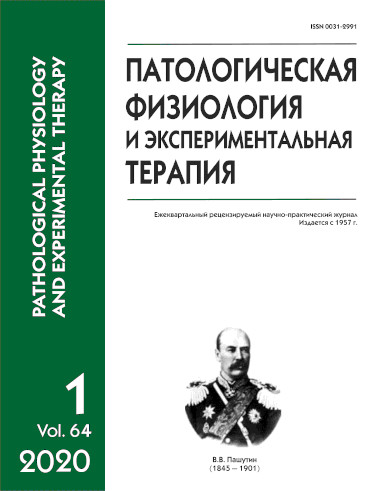Purine metabolism in patients with acute surgical pathology of abdominal organs
Abstract
Introduction. Purine metabolism was studied in 238 patients aged 18 to 62 with various acute surgical pathologies of abdominal organs. The aim of the work was to study the dynamics of xanthine oxidase (XO), the major enzyme of purine catabolism, in patients with acute surgical pathology of abdominal organs in the postoperative period. Methods. The clinical group included 238 patients with various acute surgical pathologies of abdominal organs. Mean age of patients was 37.5+1.0, from 18 to 62. The group consisted of 166 males (69.7%) and 72 females (30.3%). In parallel blood samples, we measured indexes of lipid peroxidation (LP), uric acid metabolism, concentrations of middle molecules, bilirubin, alanine transaminase and aspartate transaminase, urea, creatinine, potassium, glucose, and crude protein; counted leukocytes and erythrocytes; and determined the hemoglobin value and leukocyte intoxication index (LII). XO activity was determined according to a method of J.H. Marimont and M. London modified at the Medical School of I. N. Uliyanov Chuvash State University. Concentration of malonic dialdehyde (MDA) was measured according to the recommendations of A.L. Tappel and H. Lalkin, and concentrations of middle molecules (MM254 and MM280) were measured according to C. Holloway et al. Normal values for serum concentrations of XO, MDA, MM254, and MM280 were determined using a random sample of Chuvash Republic residents. Results. Upon admission of patients, their XO activity significantly exceeded normal values. Starting from postoperative day 1, the enzyme activity increased, reached its maximum at day 3, then decreased, and approached the baseline values by day 7. A direct correlation of XO and MDA, the end product of lipid peroxidation (LP), was established, which confirmed that the increase in purine catabolism associated with acute surgical pathology is coupled with LP activation. The correlation between the increase in purine catabolism and LP activation in acute surgical pathology is consistent with multiple reports of XO involvement in free radical production. Conclusions. Intensity of LP processes is closely related to the degree of intoxication as evidences by direct, strong correlations of XO with concentrations of middle molecule 254, middle molecule 280, leukocyte count, and LII. In case of unfavorable postoperative course, two types of changes in the XO activity were identified. In some patients, the postoperative XO activity remained high significantly exceeding the normal values, whereas others had significantly decreased XO activity as compared to normal values. An increase or a sharp decrease in the XO activity with progressive clinical signs of intoxication along with increases in leukocyte count and LII can serve as an additional diagnostic sign of developing postoperative complications.






